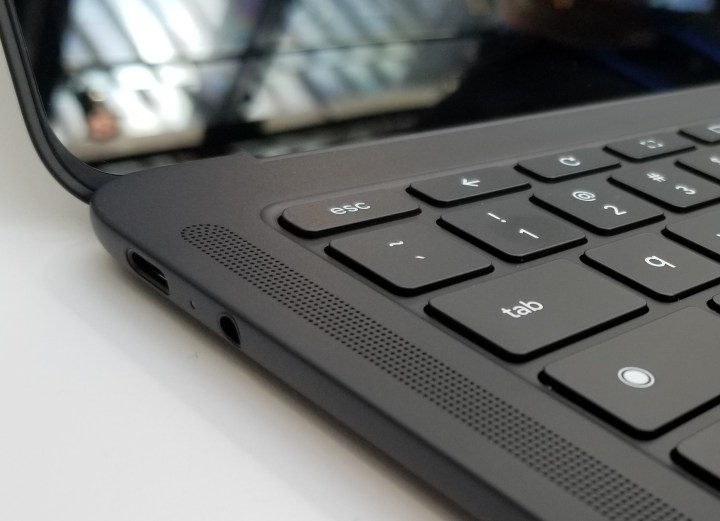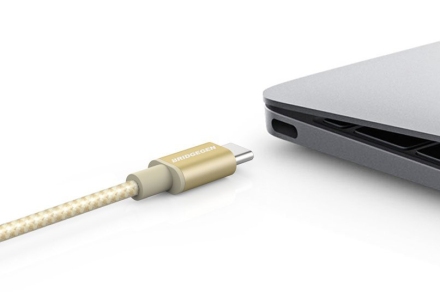- Like
- SHARE
- Digg
- Del
- Tumblr
- VKontakte
- Flattr
- Buffer
- Love This
- Save
- Odnoklassniki
- Meneame
- Blogger
- Amazon
- Yahoo Mail
- Gmail
- AOL
- Newsvine
- HackerNews
- Evernote
- MySpace
- Mail.ru
- Viadeo
- Line
- Comments
- Yummly
- SMS
- Viber
- Telegram
- JOIN
- Skype
- Facebook Messenger
- Kakao
- LiveJournal
- Yammer
- Edgar
- Fintel
- Mix
- Instapaper
- Copy Link
The arrival of USB-C and USB-C laptop chargers has been a game-changer for many electronics. You can use the connection to charge devices and transfer media, and it’s conveniently reversible. Top laptops no longer need a big power brick — you can just use USB-C.
But there are some precautions you should take when charging over USB-C. Here’s everything you need to know.
USB charging and laptops
You have probably already used USB connections to charge smaller devices either from your computer or from an outlet. That works well because past USB connections had enough wattage to successfully power up those smaller batteries. Prior versions of USB could only handle a limited amount of power, which is why laptop chargers have typically retained their larger, bulkier cables.
USB-C changed that. This type of connection now provides enough power to juice up most laptops (particularly the Type-C 3.0 version). That’s why laptop charging is a new topic of conversation for USB connections, especially now that more laptops are entering the market with USB-C charging compatibility.

So, how do you know if your current laptop has a USB-C port that also works with charging? You could always look it up, but the easiest way is to simply examine your charger. You can identify a Type-C charger by its unique features. USB-C’s connector is small and rounded, significantly different from the old USB version. It also works no matter which way you connect it to the right port, so there’s no need to flip it the right way around. If your charger uses this connection and plugs into your USB-C port, you have a winner!
USB-C chargers are turning up on many different devices, so it’s not strictly relegated to laptops. Newer phones use USB-C charging, car chargers may come with USB-C ports, and portable chargers (discussed more below) can have USB-C options. But laptops tend to have USB-C more frequently than other devices, at least for now.
Will any port work with any charger?
USB-C is a universal charging standard. That means that, technically, it doesn’t matter what USB-C charger you use — it should be able to power up a laptop with a USB-C charging port and power bank. In the real world, this is taking a while to come true. Today the majority of laptop USB-C chargers are interchangeable, but it’s not guaranteed.
Some laptops come with USB-C ports that don’t charge. This is most common on laptops that come with their own proprietary charger — although a number of laptops can be charged either way, only the propriety charger tends to power up a laptop more quickly. The Samsung Notebook 9 is an example of that, as is the 2019 HP Envy 13. If you’re not sure exactly how to charge your laptop, check the manufacturer’s website, or look up a review of the system here at Digital Trends.
Laptops that rely entirely on USB-C, meanwhile, might not charge with just any charger. PCWorld, in its testing, found that HP’s Spectre x2 wouldn’t charge with any USB-C charger besides its own. HP said that that was intentional because a bad charger could damage the device or cause it to malfunction. Other devices, like the Apple MacBook Pro, don’t have such tight restrictions — a new USB-C authentication system could help with this issue in the near future.
While we haven’t personally heard of any damage from using a USB-C charger other than the one that came with your laptop, there’s always a slim risk when plugging a laptop into an unknown power source. Faulty cables can also be a problem. Microsoft acknowledges this by saying that you can charge a Surface with a USB-C port, but it’s highly recommended that you use the Surface charger that came with the laptop because a USB-C charger would end up being very slow due to how power is metered within the device. In short, it’s a good idea to buy cables and chargers from reputable sources and think twice about using that cable you found laying on the ground in a conference room.
You can buy additional USB-C cables for your own security.
Your settings are important
You will also want to watch your USB-C power mode, which you can find in your laptop settings, usually in the power/battery section. Here, you may find that you can switch Type-C’s output, choosing whether to receive power or send power. If your USB-C laptop charger isn’t working when by all rights it should be, check your settings to make sure it is set to receive power.
Complex charging arrangements

Because USB-C is universal and can do multiple things at once, this allows for some unique charging circumstances. Two worth noting are:
Pass-through: Today’s charging hubs also offer something called pass-through charging. This refers to a hub that can connect multiple USB peripherals to a laptop while also charging that laptop’s battery. Basically, it’s a combination between a hub and a USB-C charging cable, so you don’t need two different USB-C ports for each task. HooToo’s popular 6-in-1 USB-C Hub is a good example of this technology. There are other innovative options, too, like sending video to an external monitor while also making sure your laptop is charged during a presentation.
Portable chargers: Maybe you have a portable charger with an old USB connection but a phone that only has a USB-C connection (which is not compatible with older USB ports). You can link the charger to a laptop that has both types of ports, and use it to power up your phone in a roundabout way. Do not try to use your laptop Type C charger to charge your phone directly. The voltage requirements are too different for most devices currently available, and multi-device chargers are still a nascent part of the market.
USB-C and Thunderbolt 3

There’s a variant of USB-C that’s a lot more powerful — Thunderbolt 3. Choose a laptop with at least one Thunderbolt 3-enabled USB-C port, and you can connect multiple 4K monitors at 60Hz and greatly increase your laptop’s gaming performance via an external GPU enclosure.
Thunderbolt 3 allows for a number of charging arrangements: It can “chain” up to six different devices together and easily charge while transmitting data at higher speeds than USB-C alone, up to 100W.
Since Thunderbolt 3 uses the same connection as USB-C, manufacturers are quick to label laptop ports if they also have Thunderbolt 3 technology — you can usually tell just by reading their descriptions. However, Thunderbolt 3 connections only work if you use the right cables, so make sure you have Thunderbolt 3 cables if you want to take advantage of those ports’ full features and bandwidth.
For Apple users

Apple users should know that they aren’t immune to the USB-C transition we’re seeing. Currently, Apple uses Lightning cables for iOS charging, a proprietary design that silos off of all Apple mobile charging accessories. The company has already switched to USB-C charging for MacBooks, and today’s iPad Pros also use USB-C charging. iPhones and iPads are currently unique in their Lightning cable reliance.
Apple is going to have to reimagine its current Lightning cable situation to fulfill the EU’s suspected precedent, demanding a set model of USB-C charging cables. Failure to comply with these demands will result in the loss of valuable European laptop buyers. Combine that with speculation of Apple ditching charging cables entirely, instead of focusing on a portless setup (most likely using a magnetic attachment on the back of the iPhone), and we may see the end of the Lightning cable in the next couple of years.
Furthermore, a recent rumor suggests that Apple will forgo its Lightning port for all its devices, starting with its iPhone range from 2025 onward. Another report also highlights how the company is reportedly preparing to remove the port entirely from the AirPods’ charging case, mice, etc.
The future of USB-C charging
Current USB options are about to receive a major overhaul. According to industry insiders, not only will USB have the fastest speeds ever, but they will also be universally compatible across all brands of devices. The dawn of 2021 could see an entirely new generation of laptops that espouse the new USB4 port. Of course, USB4 adds yet another layer of complexity when it comes to USB protocols. There’s even more to know about the new tech:
- USB4 will be available on USB-C ports.
- USB4 increases speeds and charging power to match Thunderbolt 3, up to 100W.
- USB4 will require cables formatted for USB4 to enable its new features.
- USB4 will be backward compatible with USB 2.0.
We’re guessing that all other ports may start giving way to the USB-C. USB-C ports will soon outweigh all other ports in importance, taking over as the primary port. In the future, USB4 and Thunderbolt will likely be the standard.
Frequently Asked Questions
Do all USB-C ports allow charging?
Although USB-C is increasingly becoming more commonplace as the go-to standard for charging, it doesn’t necessarily mean that all USB-C ports allow charging.
There are certain laptops — generally the systems that sport their own charger — that feature USB-C ports which don’t offer charging capabilities.
Can I charge my laptop via USB-C?
Generally speaking, if your laptop comes with a USB-C charging feature, then you should have no problem with charging your system via USB-C. That said, some mobile systems (notebooks and laptops) require you to use a specific cable that is exclusively made to be compatible with that system.
Is USB-C charging better?
USB-C charging is better than any other alternative charging platform. Due to the advanced technical capabilities of the standard, using USB-C charging for your system means it will generally charge it faster than, say, a regular power cable.
For example, a USB Type-C cable that offers up to 240 watts of power was recently revealed, which is unheard of for USB-C. It just goes to show the possibilities that USB-C brings with it.
Can USB-C let you charge your laptop without a charger?
Yes, and no. Providing your notebook or laptop comes with a USB-C port that was specifically designed to supply charging support, then you can charge it without a regular charger. However, as we mentioned above, not all laptops offer USB-C ports that you can utilize in order to charge your device.
Editors’ Recommendations
- AMD Ryzen 6000: Everything you need to know
- Corsair’s first gaming laptop ever goes all-in on AMD
- The best Intel processors for 2022
- What is Twitter Blue and is it worth it?
- Best Apple deals and sales for May 2022



